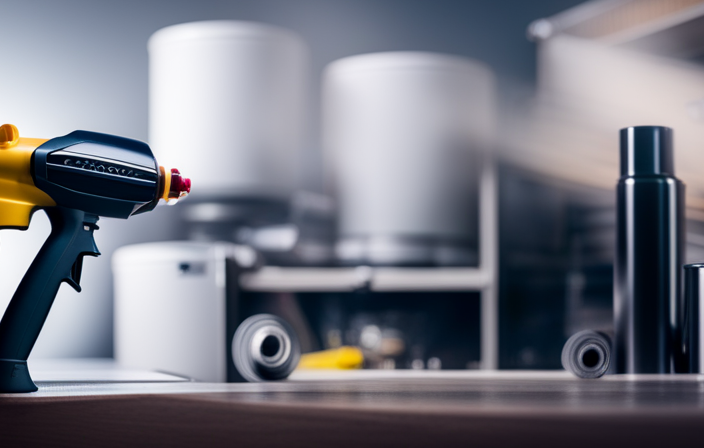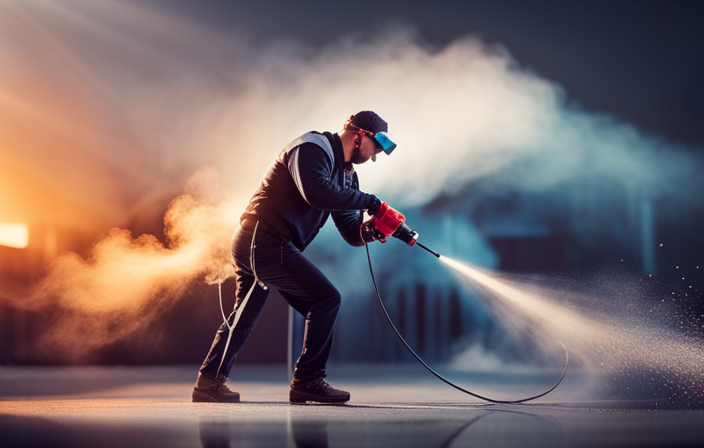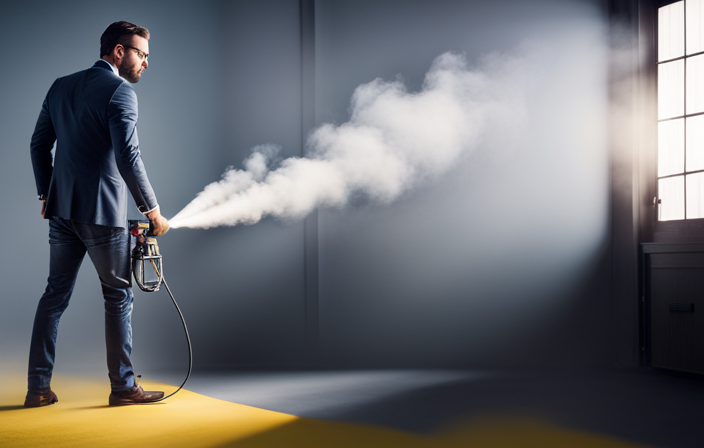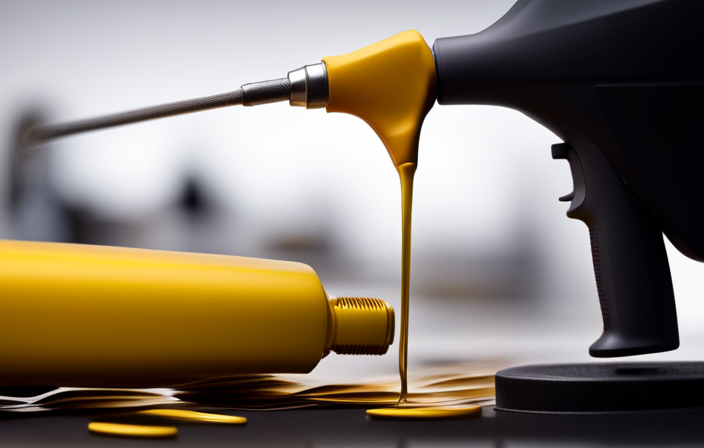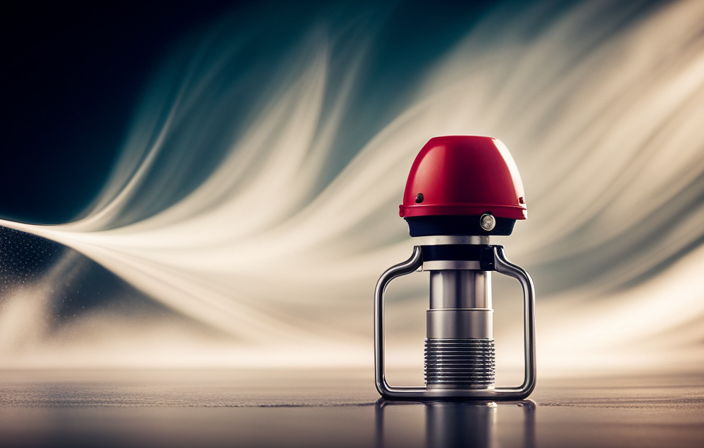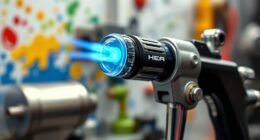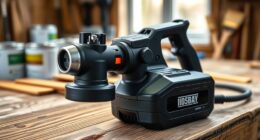I have always been adamant about keeping my tools in top condition, especially my trustworthy airless paint sprayer. It is like a loyal companion, helping to transform plain walls into works of art. However, just like any superhero, even the strongest sprayer needs a safe place to recharge after completing tasks.
That’s why I’ve dedicated countless hours to mastering the art of storing my airless paint sprayer for the long haul.
In this article, I’ll share my tried-and-true methods for keeping your sprayer in top shape during storage. From thorough cleaning and lubrication to protecting it from dust and debris, I’ve got you covered.
I’ll even guide you through inspecting and maintaining your sprayer regularly to ensure it’s always ready for action.
So, grab a cup of coffee and prepare to become a storage expert for your airless paint sprayer. Trust me, it’s a skill that will save you time, money, and plenty of headaches down the road. Let’s get started!
Key Takeaways
- Neatly wrap the power cord to prevent tangles and damage during storage.
- Regularly inspect and maintain the sprayer, including replacing worn or damaged parts.
- Clean the sprayer to remove residue or debris and prevent clogs.
- Lubricate moving parts to prevent rust and ensure smooth operation.
Clean the Sprayer Thoroughly
Make sure you clean the sprayer thoroughly by removing any excess paint and using a cleaning solution to rinse out all the nooks and crannies.
To clean the sprayer, start by emptying any remaining paint from the container and wiping it out with a clean rag. Then, disassemble the sprayer according to the manufacturer’s instructions.
Clean the spray tip, gun, and other removable parts using a brush or toothbrush to remove any dried paint. For stubborn paint, you can also use a cleaning solution specifically designed for airless paint sprayers.
After cleaning, rinse all the parts with water to remove any residue. Make sure to dry all the parts thoroughly before reassembling the sprayer. With proper cleaning techniques and recommended cleaning products, your sprayer will be ready for storage.
Now, let’s move on to the next section about emptying and cleaning the paint container.
Empty and Clean the Paint Container
To ensure your airless paint sprayer remains in good condition, start by thoroughly emptying and cleaning the container.
Cleaning the paint container is an essential step in maintaining your sprayer and preventing any clogs or build-up. After completing your painting job, remove any remaining paint from the container by pouring it back into the original paint can or a separate container.
Next, fill the container with warm water and add a few drops of dish soap. Shake the container vigorously to loosen any dried paint or residue. Use a brush or sponge to scrub the inside of the container, making sure to reach all the corners and crevices.
Rinse the container thoroughly with clean water until all soap residue is removed. Properly cleaning the paint container will ensure that your sprayer is ready for storage and will prevent any issues when you use it again.
Now, let’s move on to disconnecting and cleaning the spray gun.
Disconnect and Clean the Spray Gun
After you’ve finished painting, it’s time to disconnect and give the spray gun a thorough cleaning. Cleaning the spray gun is an essential part of the maintenance process for your airless paint sprayer. Proper cleaning ensures that the gun functions optimally and extends its lifespan. To clean the spray gun, follow these steps:
| Step | Procedure |
|---|---|
| 1 | Disconnect the gun from the hose by unscrewing it counterclockwise. |
| 2 | Remove the nozzle and filter from the gun. |
| 3 | Rinse the nozzle and filter with warm water to remove any paint residue. |
This cleaning process helps prevent clogs and blockages that can affect the spray pattern. It’s crucial to ensure that all paint residue is completely removed from the gun to avoid any issues during future use. Once the spray gun is clean and dry, it’s time to move on to the next maintenance step, which is lubricating the moving parts.
Lubricate Moving Parts
To ensure smooth operation and prolong the lifespan of your spray gun, it’s essential that you lubricate its moving parts regularly.
A well-lubricated spray gun can reduce friction by up to 80%, resulting in a more efficient and enjoyable painting experience.
Lubricating the moving parts not only prevents rust but also extends the lifespan of your airless paint sprayer.
Start by applying a few drops of lubricant to the trigger, valve, and any other moving components.
Gently move the parts back and forth to distribute the lubricant evenly.
This simple maintenance step will keep your spray gun in optimal condition and prevent any unnecessary wear and tear.
Moving on to the next section about protecting the sprayer from dust and debris, it’s important to take additional measures to maintain its performance.
Protect the Sprayer from Dust and Debris
To protect the sprayer from dust and debris, it is important to take certain precautions. Regularly cleaning the exterior surfaces of the sprayer is crucial to prevent contaminants from entering. This can be done by wiping down the sprayer with a damp cloth or using compressed air to blow away loose particles. Storing the sprayer in a dedicated storage solution, such as a protective case or bag, can provide an extra layer of protection. By implementing these cleaning techniques and storage solutions, you can ensure that your airless paint sprayer remains in excellent condition. In the next section, we will discuss the importance of storing the sprayer in a dry and temperature-controlled area.
Store in a Dry and Temperature-Controlled Area
To keep your airless paint sprayer safe and protected, store it in a dry and temperature-controlled area. Proper storage techniques are crucial to prevent rust and corrosion. Moisture can damage internal components, leading to decreased performance and potential breakdowns.
To avoid this, find a storage space that is dry and free from excessive humidity. It’s also important to control the temperature, as extreme heat or cold can negatively impact functionality. Aim for a consistent temperature range of around 50-75 degrees Fahrenheit.
By storing your airless paint sprayer in a dry and temperature-controlled area, you can prevent rust and corrosion, ensuring its longevity.
Transitioning to the next section, using a cover or case for added protection is another effective step in preserving your sprayer’s condition.
Use a Cover or Case for Added Protection
Using a cover or case is like adding an extra layer of armor to shield your airless paint sprayer from potential damage. There are several benefits of using a cover or case for your airless paint sprayer.
Firstly, it protects the sprayer from dust, debris, and moisture, ensuring that it stays clean and in optimal condition for longer periods. Additionally, it prevents accidental bumps and scratches, which can lead to functional issues or cosmetic damage.
When choosing the right cover or case for your airless paint sprayer, consider the material’s durability, waterproofing capabilities, and ease of use. Look for covers or cases specifically designed for airless paint sprayers to ensure a proper fit and maximum protection.
By using a cover or case, you can extend the lifespan of your airless paint sprayer and keep it in top-notch condition. This is essential for achieving flawless paint finishes.
Now, let’s move on to the next section about checking and replacing any worn or damaged parts.
Check and Replace any Worn or Damaged Parts
To ensure your airless paint sprayer is in optimal condition, you need to regularly check and replace any worn or damaged parts. This is an essential part of maintenance that will prolong the lifespan of your sprayer and ensure consistent performance. When inspecting your sprayer, pay close attention to components such as the spray tip, gun filter, and pump packings. These parts often experience wear and tear due to frequent use and exposure to paint materials. Replace any worn parts immediately to avoid compromising the functionality of your sprayer.
To assist you in identifying common worn parts and their replacements, refer to the table below:
| Worn Part | Replacement |
|---|---|
| Spray Tip | Replace with a new tip |
| Gun Filter | Install a fresh filter |
| Pump Packings | Swap with new packings |
By regularly checking and replacing worn parts, you can ensure that your airless paint sprayer operates smoothly and efficiently. Once you have completed this maintenance, you can move on to the next step of storing your sprayer with the power cord wrapped neatly.
Store with the Power Cord Wrapped Neatly
When storing your airless paint sprayer, ensure that the power cord is neatly wrapped to prevent any tangles or damage. Proper storage techniques are crucial to maintaining the longevity of your sprayer and preventing damage.
Start by unplugging the cord from the power source and untangling any knots or kinks. Gently coil the cord, making sure not to twist or bend it excessively. Avoid wrapping the cord tightly around the sprayer or any other objects, as this can cause strain and potential damage.
Store the wrapped cord in a dry and clean area, away from any sharp objects or extreme temperatures. By following these steps, you can ensure that your power cord remains in excellent condition and ready for use. Regularly inspecting and maintaining the sprayer during storage is equally important for optimal performance.
Regularly Inspect and Maintain the Sprayer during Storage
After ensuring the power cord is wrapped neatly, it’s important to regularly inspect and maintain the airless paint sprayer during storage. This is crucial for maintaining the sprayer’s performance and prolonging its lifespan.
Begin by inspecting the sprayer’s parts, such as the nozzle, filter, and hose, for any signs of wear or damage. Replace any worn or damaged parts to prevent potential issues during future use.
Additionally, it’s important to clean the sprayer thoroughly before storage to remove any paint residue or debris that may have accumulated. This will prevent clogs and maintain optimal performance.
Lubricating moving parts, such as the piston and seals, is also recommended to prevent rust and ensure smooth operation.
By regularly inspecting and maintaining the sprayer, you can ensure it’s in top condition when you need it for your next painting project.
Frequently Asked Questions
Can I store the airless paint sprayer outside?
I wouldn’t recommend storing an airless paint sprayer outside. Exposure to extreme temperatures, moisture, and UV rays can damage its components. To ensure its longevity, follow proper maintenance tips and store it indoors in a clean and dry area.
How often should I clean the spray gun?
To maintain optimal performance, it is advisable to clean the spray gun after each use. Follow the manufacturer’s instructions on how to clean an airless paint sprayer, and be sure to remove any clogs or residue. Regular maintenance is key to prolonging the lifespan of your spray gun.
Do I need to clean the paint container after every use?
Yes, it is important to clean the paint container after every use to maintain the performance and longevity of your airless paint sprayer. Proper cleaning frequency and storage will help prevent clogs and ensure optimal functionality.
Can I store the sprayer in a garage with fluctuating temperatures?
Storing the sprayer in a garage with fluctuating temperatures is not ideal. Temperature changes can damage the sprayer and affect its performance. Consider storing it in a climate-controlled area or finding other suitable storage options.
Is it necessary to inspect and maintain the sprayer during storage?
Yes, it is necessary to inspect and maintain the sprayer during storage. Regular inspection ensures it is in good condition, while maintenance prevents issues like clogging or damage. This ensures optimal performance when you use it again.
Conclusion
In conclusion, properly storing your airless paint sprayer is essential for its longevity and performance. Follow these steps to clean, maintain, and protect your sprayer during storage.
Regular inspections and maintenance will identify worn or damaged parts that need replacing.
Wrap the power cord neatly and consider using a cover or case for added protection.
By taking these measures, you can extend the life of your airless paint sprayer and ensure its reliability for future use.
